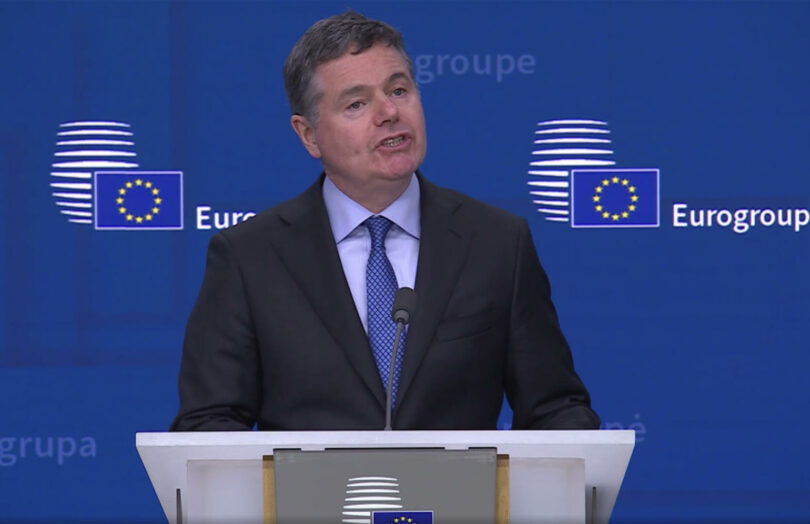Following a meeting of the Eurogroup of EU finance ministers yesterday, participants promoted the idea that there’s now an urgent need for a European central bank digital currency (CBDC), or digital euro, because Donald Trump wants dollar stablecoins to proliferate worldwide.
While there are valid concerns about monetary sovereignty, several other options exist (see below) to address concerns other than a CBDC.
In fact, the EU’s MiCA regulations and the digital euro were initiated following monetary sovereignty threats from Facebook’s Libra stablecoin. As a result, MiCA includes sovereignty protections, limiting the scale of any single foreign stablecoin for everyday payments. We previously highlighted this when ECB Director Piero Cipollone made similar comments.
The Trump stablecoin threat is being trotted out at a time when legislation for a digital euro still needs agreement. Before last year’s election, the passage of digital euro legislation seemed a foregone conclusion. Approval is still likely, but has hit some road bumps since then.
For example, the person leading the legislative push, the Rapporteur Stefan Berger, stepped aside because of his own skepticism about the CBDC. Hence, the argument that a central bank issued CBDC is the only foil to US stablecoins presents a convenient lever to ensure the smooth progress of legislation.
There appears to be a lack of debate about alternative approaches, some of which are private sector and raise fewer concerns about government control. These options include:
- being more supportive towards Euro stablecoins, facilitating or encouraging better infrastructure
- providing better central bank support for pan-European private sector payment initiatives such as Wero
- coordinating commercial banks to create a tokenized deposit network
- further tightening MiCA’s already solid sovereignty protections.
Some of these options might be quicker solutions and cost taxpayers less. The digital euro will apparently impose major financial costs on banks.
Our opposition to retail CBDC
We understand that Europe aims to safeguard citizen privacy (with respect to governments) for the digital euro, both at a legal and technical level. We support and believe the stance is genuine.
However, recent events have highlighted that politics can change extremely rapidly. A month ago, the United States was a staunch ally of Europe. Look at the United States’ 180 degree change in stance re cryptocurrency. Perhaps even more relevant is the multiple iterations of Operation Choke Point that de-banked certain groups of people.
Whose to say that European politics won’t change as rapidly as the United States?
Privacy protections can be removed from laws for expedient reasons. And any CBDC design could be altered to share data even more easily.
If a digital euro is established and successful, it’s highly likely that within the next ten to twenty five years it will be used either to monitor citizens – even if it’s for the purpose of ensuring tax compliance – or to restrict how people can spend their money.
In our view, the recent US upheavals don’t just highlight sovereignty issues, but also the enormous dangers of a retail CBDC, given governments and laws change.
We know that the current digital euro architects don’t plan this and we sincerely hope we’re wrong. The only way to be sure is to take the option off the table.
What the ministers said re stablecoins, digital euro
Paschal Donohoe, the Irish Finance Minister and President of the Eurogroup, observed that crypto-asset markets are “evolving very fast, both politically and technologically.”
“We know this is a global market and policy developments in other jurisdictions can have important consequences for us here in Europe. So these discussions are fundamentally linked to our own autonomy and to the resilience of our currency.”
“The digital euro is critical to staying ahead of the curve in this area. A huge amount of technical work has now been done and there is growing appreciation amongst ministers of the importance of this work.”
Pierre Gramegna, Managing Director of the European Stability Mechanism, raised the topic of Facebook’s Libra and Mica:
“What is at stake here is also European Sovereignty. The US administration’s stance on this (crypto) compared to the past has changed. And the US administration is favorable towards cryptocurrency and especially dollar denominated stablecoins, which may raise certain concerns in Europe.”
“It could eventually reignite foreign and US tech giants’ plans to launch mass payment solutions based on dollar denominated stablecoins. If this were to be successful, it could affect the Euro area’s monetary sovereignty and financial stability.”
“Therefore, the ESM supports the European Central Bank’s urgency in making the digital euro a reality to safeguard Europe’s strategic autonomy. The digital euro is today more necessary than ever.”
“We also welcome as ESM and support the initiative of the Commission to relook at the Mica directive which could prove key here to counter the effects we discussed.”





























